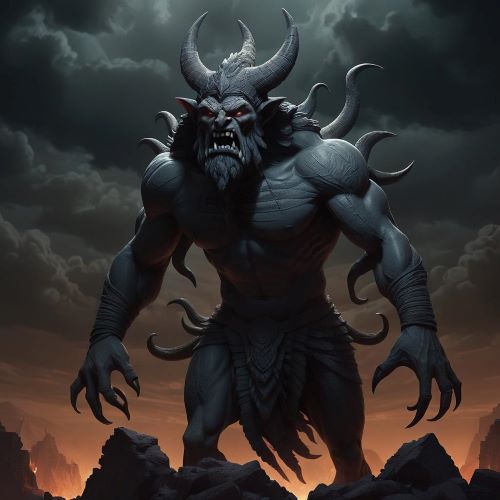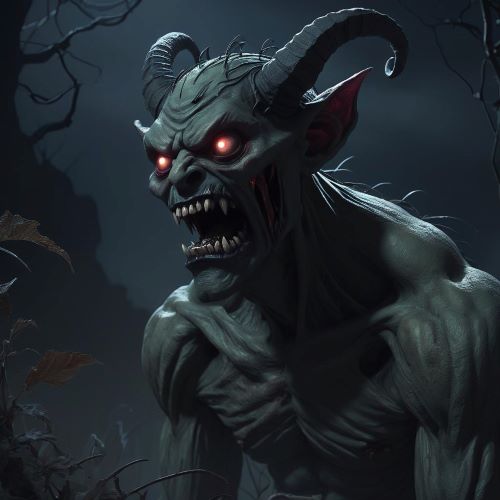Mesopotamian Spirits
Mesopotamian Spirits were an essential part of ancient Mesopotamia’s vast and complex spiritual world, existing between gods and mortals as agents of both protection and destruction. These invisible forces reflected the Mesopotamians’ understanding of a universe filled with unseen powers that influenced every aspect of life. Known through ancient texts, amulets, and temple carvings, spirits were believed to inhabit the air, water, earth, and even the human body. Some brought blessings and healing, while others brought disease and misfortune. The balance between benevolent and malevolent spirits defined the spiritual outlook of Mesopotamian civilization, where rituals, prayers, and magic were used to maintain cosmic harmony.
Protective Mesopotamian Spirits, known as utukku or lamassu, were often invoked to guard homes, temples, and cities. The Lamassu, with its human head, lion’s body, and eagle’s wings, stood as one of the most enduring symbols of divine guardianship. These spirits represented the watchful presence of the gods, standing at gateways to keep evil forces at bay. Similarly, the Apkallu, or fish-cloaked sages, were semi-divine spirits associated with the god Enki (Ea), who bestowed wisdom and rituals upon humanity to preserve balance in the world. They were depicted on palace walls and seals as protectors of kings, emphasizing the belief that divine wisdom and guidance flowed through spiritual intermediaries rather than through the gods alone.
However, not all Mesopotamian Spirits were benevolent. Malevolent entities such as the utukku lemnūtu, asakku, and lilu were blamed for illness, nightmares, and misfortune. These dark spirits often emerged when the natural and spiritual balance was disturbed—through forgotten rituals, broken oaths, or neglected burials. The ancient Mesopotamians believed that such spirits could possess humans or cause suffering until appeased or banished. Exorcists, known as āšipu, played a vital role in countering these forces. They performed purification rites, recited incantations, and used amulets or figurines to drive out evil spirits. This dynamic relationship between humans and spirits reveals how deeply spiritual and psychological health were intertwined in Mesopotamian belief.
The underworld, ruled by the goddess Ereshkigal, was also populated by numerous Mesopotamian Spirits. The souls of the dead, called etemmu, were considered a form of spirit energy that lingered beyond life. If properly buried and remembered through offerings, they remained peaceful. If neglected, they could return to the world of the living as restless ghosts, bringing sorrow or disease. This belief inspired elaborate funerary practices meant to honor the dead and ensure spiritual balance. The Mesopotamians viewed death not as an end but as a continuation of existence in another form—a concept that profoundly influenced later ideas about the soul and afterlife in the ancient Near East.
Today, Mesopotamian Spirits continue to captivate scholars and artists with their blend of mysticism, morality, and imagination. They reveal how early civilizations understood the invisible forces of the world long before science or psychology existed. From protective guardians like the Lamassu to malevolent demons like Pazuzu, these spirits reflected the full spectrum of human emotion—fear, hope, faith, and awe. Their stories survive in artifacts, temple inscriptions, and modern reinterpretations that still inspire fascination. In their complex duality, Mesopotamian Spirits remind us that the ancient people of Mesopotamia saw the universe as a living network of visible and invisible powers—a belief that continues to echo through the world’s enduring myths and spiritual traditions.
Mesopotamian Spirits were an essential part of ancient Mesopotamia’s vast and complex spiritual world, existing between gods and mortals as agents of both protection and destruction. These invisible forces reflected the Mesopotamians’ understanding of a universe filled with unseen powers that influenced every aspect of life. Known through ancient texts, amulets, and temple carvings, spirits were believed to inhabit the air, water, earth, and even the human body. Some brought blessings and healing, while others brought disease and misfortune. The balance between benevolent and malevolent spirits defined the spiritual outlook of Mesopotamian civilization, where rituals, prayers, and magic were used to maintain cosmic harmony.
Protective Mesopotamian Spirits, known as utukku or lamassu, were often invoked to guard homes, temples, and cities. The Lamassu, with its human head, lion’s body, and eagle’s wings, stood as one of the most enduring symbols of divine guardianship. These spirits represented the watchful presence of the gods, standing at gateways to keep evil forces at bay. Similarly, the Apkallu, or fish-cloaked sages, were semi-divine spirits associated with the god Enki (Ea), who bestowed wisdom and rituals upon humanity to preserve balance in the world. They were depicted on palace walls and seals as protectors of kings, emphasizing the belief that divine wisdom and guidance flowed through spiritual intermediaries rather than through the gods alone.
However, not all Mesopotamian Spirits were benevolent. Malevolent entities such as the utukku lemnūtu, asakku, and lilu were blamed for illness, nightmares, and misfortune. These dark spirits often emerged when the natural and spiritual balance was disturbed—through forgotten rituals, broken oaths, or neglected burials. The ancient Mesopotamians believed that such spirits could possess humans or cause suffering until appeased or banished. Exorcists, known as āšipu, played a vital role in countering these forces. They performed purification rites, recited incantations, and used amulets or figurines to drive out evil spirits. This dynamic relationship between humans and spirits reveals how deeply spiritual and psychological health were intertwined in Mesopotamian belief.
The underworld, ruled by the goddess Ereshkigal, was also populated by numerous Mesopotamian Spirits. The souls of the dead, called etemmu, were considered a form of spirit energy that lingered beyond life. If properly buried and remembered through offerings, they remained peaceful. If neglected, they could return to the world of the living as restless ghosts, bringing sorrow or disease. This belief inspired elaborate funerary practices meant to honor the dead and ensure spiritual balance. The Mesopotamians viewed death not as an end but as a continuation of existence in another form—a concept that profoundly influenced later ideas about the soul and afterlife in the ancient Near East.
Today, Mesopotamian Spirits continue to captivate scholars and artists with their blend of mysticism, morality, and imagination. They reveal how early civilizations understood the invisible forces of the world long before science or psychology existed. From protective guardians like the Lamassu to malevolent demons like Pazuzu, these spirits reflected the full spectrum of human emotion—fear, hope, faith, and awe. Their stories survive in artifacts, temple inscriptions, and modern reinterpretations that still inspire fascination. In their complex duality, Mesopotamian Spirits remind us that the ancient people of Mesopotamia saw the universe as a living network of visible and invisible powers—a belief that continues to echo through the world’s enduring myths and spiritual traditions.



